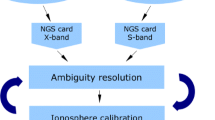Abstract
The Hartebeesthoek Radio Astronomy Observatory (HartRAO) is the only very long baseline interferometry (VLBI) station in Africa, its importance to the current and future network is discussed in the presented analysis. In order to quantify the contribution of the HartRAO station to VLBI products, different approaches (e.g. comparison of number of observations to sources, formal errors of EOP and baseline length repeatabilities) are analysed. Two datasets were used, CONT08 and IVS-R1 sessions from the years 2011 and 2012. The results suggest that the station is of high importance to the current and future global VLBI network. In particular, HartRAO is crucial for maintaining the ICRF on the Southern Hemisphere; it is also one of the most important stations for the estimation of polar motion and nutation (e.g. when HartRAO is excluded from different networks the formal error of nutation increases by about 50 %). The quality of the station coordinates of remote southern stations such as TIGOCONC is also heavily dependent on HartRAO.








Similar content being viewed by others
References
Altamimi Z, Collilieux X, Métivier L (2011) ITRF2008: an improved solution of the international terrestrial reference frame. J Geod 85(8):457–473
Behrend D, Nothnagel A (2013) International VLBI service for geodesy and astrometry (IVS). In: Report of the international association of geodesy 2011–2013 - Travaux de l’Association Internationale de Géodésie 2011–2013, vol 38, pp 364–371
Böhm J, Böhm S, Nilsson T, Pany A, Plank L, Spicakova H, Teke K, Schuh H (2012) The new Vienna VLBI software VieVS. In: Proceedings of the 2009 IAG symposium, Buenos Aires, 31 Aug- - 4 Sept 2009. International Association of Geodesy Symposia, vol 136, pp 1007–1011
Fey A, Gordon D, Jacobs C (2009) The second realization of the international celestial reference Frame by very long baseline interferometry. IERS technical note 35. Verlag des Bundesamts für Kartographie und Geodäsie, Frankfurt am Main
Hase H (2010) Zur Bedeutung von TIGO zur Bestimmung des ITRF, der EOP, EUREF und GREF. Technical report. http://www.tigo.cl/documents/100127BedeutungTIGO.pdf
Lovell J, McCallum J, Reid P, McCulloch P, Baynes B, Dickey J, Shabala S, Watson C, Titov O, Ruddick R, Twilley R, Reynolds C, Tingay S, Shield P, Adada R, Ellingsen S, Morgan J, Bignall H (2013) The auscope geodetic VLBI array. J Geod 87(6):527–538
Nicolson G (1995) VLBI at the hartebeesthoek radio astronomy observatory. Astrophys Space Sci 230: 329–339
Nothnagel A, Nicolson GD, Schuh H, Campbell J, Cloppenburg H, Kilger R (1988) Radiointerferometric polar motion determination using a very long north-south baseline. In: Babcock AK , Wilkins GA (eds) The Earth’s rotation and reference frames for geodesy and geodynamics, vol 128, IAU Symposium, p 193
Pany A, Böhm J, MacMillan D, Schuh H, Nilsson T, Wresnik J (2011) Monte carlo simulations of the impact of troposphere, clock and measurement errors on the repeatability of VLBI positions. J Geod 85(1):39–50
Petit G, Luzum B (eds) (2010) IERS Conventions 2010. In: IERS Technical note No. 36, Frankfurt am Main, Verlag des Bundesamts für Kartographie und Geodäsie
Petrachenko. B, Niell A, Behrend D, Corey B, Böhm J, Charlot P, Collioud A, Gipson J, Haas R, Hobiger T, Koyama Y, MacMillan D, Malkin Z, Nilsson T, Pany A, Tuccari G, Whitney A, Wresnik J (2009) Design aspects of the VLBI2010 system. Progress report of the IVS VLBI2010 committee. Technical report. http://adsabs.harvard.edu/abs/2009vlbi.rept....1P
Schuh H, Behrend D (2012) VLBI: a fascinating technique for geodesy and astrometry. J Geodyn 61:68–80
Schuh H, Böhm J (2013) Very long baseline interferometry for geodesy and astrometry. In: Xu G (ed) Sciences of geodesy-II. Springer, Berlin, pp 339–376
Sovers OJ, Fanselow JL, Jacobs CS (1998) Astrometry and geodesy with radio interferometry: experiments, models, results. Rev Mod Phys 70(4):1393–1454
Sun J, Böhm J, Nilsson T, Krásná H, Böhm S, Schuh H (2014) New VLBI2010 scheduling strategies and implications on the terrestrial reference frames. J Geod 88(5):449–461
Acknowledgments
The authors would like to thank the Hartebeesthoek Radio Astronomy Observatory and the Vienna University of Technology for providing financial support for this work, as well as the University of Pretoria for providing facilities and assistance. David Mayer and Johannes Böhm are grateful to the Austrian Science Fund (FWF) for supporting project P23143-N21 (”Integrated VLBI”).
Author information
Authors and Affiliations
Corresponding author
Rights and permissions
About this article
Cite this article
Mayer, D., Böhm, J., Combrinck, L. et al. Importance of the Hartebeesthoek Radio Astronomy Observatory for the VLBI network. Acta Geod Geophys 49, 313–325 (2014). https://doi.org/10.1007/s40328-014-0063-7
Received:
Accepted:
Published:
Issue Date:
DOI: https://doi.org/10.1007/s40328-014-0063-7




